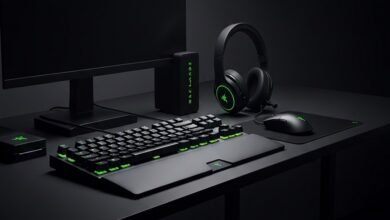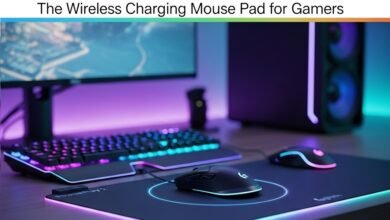USB-C Docking Stations & Multi-Port Hubs: The Essential Tech Companions of 2025
In today’s hybrid work era, where people seamlessly switch between laptops, tablets, and smartphones, USB-C docking stations and multi-port hubs have become absolute essentials. They transform a single port into a productivity powerhouse—connecting displays, peripherals, and storage with ease. But how do these devices differ, and which is right for you? Let’s dive into the features, comparisons, and trends shaping USB-C hubs in 2025.
The Rise of USB-C: Why It Matters ⚡🔄
USB-C has become the universal standard for charging, data transfer, and video output. From MacBooks to Windows laptops, iPads to Android phones, most modern devices now rely on USB-C as their main port. While minimalistic designs have eliminated multiple legacy ports, docking stations and hubs step in to restore connectivity and expand functionality.
- Docking Stations: Full-featured, designed for desk setups.
- Multi-Port Hubs: Compact, travel-friendly, ideal for on-the-go use.
Both categories meet the growing need for flexibility in work and entertainment.
What is a USB-C Docking Station? 🖥️🛠️
A docking station is essentially a command center for your laptop or tablet. It typically includes:
- Multiple HDMI or DisplayPort outputs for dual or triple monitors.
- Ethernet ports for stable wired internet.
- USB-A and USB-C slots for accessories and storage.
- Power Delivery (PD) passthrough up to 100W or more.
- Audio jacks and sometimes SD card readers.
👉 Ideal for professionals with permanent setups, docking stations turn your portable laptop into a desktop-level workstation.
What is a Multi-Port Hub? 🔌✈️
A multi-port hub is like a pocket-sized utility tool. Typically lightweight and portable, it offers:
- A few USB-A ports for peripherals.
- An HDMI port for connecting one external display.
- Card readers and sometimes Ethernet.
- Pass-through charging for convenience.
👉 Perfect for students, digital nomads, and frequent travelers, hubs give you extra connections without the bulk of a docking station.
Performance & Power Delivery ⚡🔋
One of the key factors in choosing between the two is power delivery (PD).
- Docking Stations: Often support higher wattage charging (100W+), enough to power demanding laptops like MacBook Pro or gaming ultrabooks.
- Multi-Port Hubs: Usually cap around 60–87W, which works fine for lightweight laptops and tablets but may fall short for heavy users.
👉 Verdict: For serious multitasking, docking stations win. For lightweight convenience, hubs are sufficient.
Port Selection & Productivity 📂🖱️
- Docking Stations: Offer expansive connectivity—multiple displays, ethernet, external drives, and peripherals all at once. They are designed for home offices or creative studios where productivity is key.
- Multi-Port Hubs: Offer just enough ports for everyday needs—charging, one monitor, and USB accessories. They’re meant for mobility, not full desk setups.
👉 Verdict: If your workflow involves editing videos, coding, or financial modeling across multiple screens, go for a dock. If you’re mostly into note-taking, casual browsing, or light multitasking, a hub is enough.
Design & Portability 🧳💼
- Docking Stations: Bulky, desk-bound, and often require external power adapters.
- Multi-Port Hubs: Sleek, slim, and fits easily in a backpack or even a pocket.
👉 Verdict: Docking stations are anchored at your desk, while hubs are companions on the move.
Pricing & Value 💰⚖️
- Docking Stations: Priced higher, often ranging between $120–$300+, reflecting their advanced features.
- Multi-Port Hubs: Budget-friendly, usually $30–$90, making them accessible for students and travelers.
👉 Verdict: Docking stations are an investment for productivity, hubs are a cost-effective upgrade for flexibility.
Tech Trends in 2025 🔮📈
The docking station and hub market is booming, thanks to several trends:
- Remote & Hybrid Work: Professionals want seamless work transitions between office and home.
- Single-Cable Lifestyle: Users expect one USB-C cable to handle charging, video, data, and internet.
- Sustainability: Eco-friendly materials and recyclable packaging are now selling points.
- Gaming & Creators: High-end docks designed for 4K/8K monitors and fast data transfer appeal to content creators and gamers alike.
Final Verdict 🏆
Both USB-C docking stations and multi-port hubs solve the problem of limited connectivity in modern devices, but the choice depends on your lifestyle:
- Choose a USB-C Docking Station if you work from a fixed desk setup with multiple monitors, heavy workloads, and power-hungry laptops.
- Go for a Multi-Port Hub if you value portability, travel light, and need quick access to a few extra connections.
In 2025, having one of these is no longer optional—it’s a necessity for modern digital life. Whether you’re a student, a remote professional, or a creative, a docking solution ensures you’re always connected, powered, and ready to go. 🔌💻🚀



